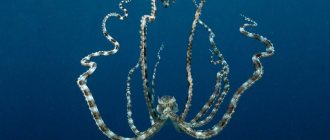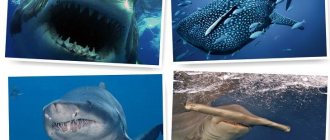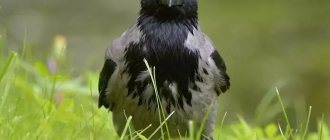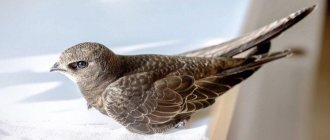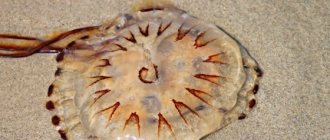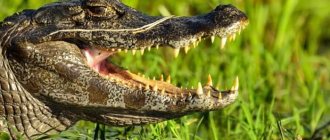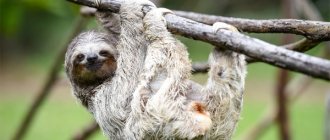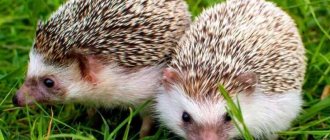Octopuses (otherwise this animal is called an octopus) have played the terrible role of sea monsters in the history of oral folk art. And in the author’s literature, a giant cephalopod with long tentacles has become the absolute embodiment of the evil principle (this description is found in Victor Marie Hugo’s novel “Toilers of the Sea”). In reality, this harmless creature suffers much more from people than is actually capable of causing them even minimal harm.
Have you tried octopus?
- Yes 71%, 627 votes
627 votes 71%627 votes - 71% of all votes
- No 29%, 258 votes
258 votes 29%
258 votes - 29% of all votes
Total votes: 885
18.10.2019
- Yes 71%, 627 votes
627 votes 71%627 votes - 71% of all votes
- No 29%, 258 votes
258 votes 29%
258 votes - 29% of all votes
Total votes: 885
18.10.2019
×
You or from your IP have already voted.
Appearance
The image of the octopus is truly unusual: the head is practically fused with the mantle, and the long tentacles (of which there are usually eight in accordance with the name, but there are species with fewer) are studded with suckers on the bottom, which play the role of taste buds for the octopus. Like a lizard throwing back its tail, if threatened, the octopus can get rid of one of its legs in order to divert the enemy’s attention to it: the discarded limb floats and wriggles for some time. Another weapon of the octopus is ink, a cloud of which the mollusks release from their sac, disorienting the attacker. This equipment of protective equipment is not accidental; in nature, octopuses have enough enemies. They are happily devoured by sea predators: sharks, moray eels, eels, dolphins, seals, seals, sea lions.
@ PantherMediaSeller – depositphotos.com
Octopuses, depending on the species, can vary quite greatly in size: from 20 cm to 3 meters. The length of the tentacles usually significantly exceeds the body size. Most members of the family still do not reach one and a half meters, but among them there are also huge creatures weighing up to 50 kg. In 1945, a record was registered: a huge octopus weighing 180 kg and 8 m long was caught off the coast of the United States. And the smallest octopus does not even reach one centimeter (it is called Octopus Wolfi).
The native color of the octopus living in the sea is brown, red or yellow. However, this mollusk is a real chameleon. It takes him a matter of seconds to adjust his color to his environment. It is helped in this by chromatophore cells that change color during the process of stretching and contracting. Real fact: an octopus pulled out of the water was able to completely reproduce on its body even the lines printed in the newspaper on which it was placed. Such camouflage helps both to hide from enemies and to get close to the sea inhabitants on which it feeds. The mollusk changes color even at the peak of strong emotions: it turns pale from fear, and when angry, it becomes deep red.
There are several species of sea octopuses, the most famous of which are:
- deep-sea (otherwise they are called fin);
- blue-ringed (the most dangerous and poisonous);
- Argonauts (their females look atypical for cephalopods because they have a shell);
- Doflein's octopus (Enteroctopus dofleini, a giant octopus that lives in the North Pacific Ocean and adjacent seas).
Structure of tentacles and beak
The tentacles extend from the head of the mollusk, thinning as they move away. Each of them has from one to three rows of suckers, and in total there can be up to two thousand of them in an adult. In males, one of the tentacles - the hectocotylus - plays the role of a genital organ. Some octopuses also have special fins that act as a kind of rudder when moving. Mollusks usually swim slowly; more often they do not even swim, but move along the bottom on half-bent tentacles.
The octopus's mouth is called the beak because it is surrounded by hard, chitinous jaws that crush fish and other food. The octopus is not able to swallow the prey whole, and even after the jaws work, the food is not crushed enough: the mollusk passes it through a special grater in the throat, bringing the food to a mushy state.
@ Cloud7Days — depositphotos.com
How many eyes
The octopus has two eyes, and their structure is similar to the structure of the human organs of vision. They consist of:
- lens, a kind of lens of biological origin;
- transparent cornea;
- irises;
- the retina, which converts light entering the eye into nerve signals.
Octopuses can see only 2.5 m around them, but they have panoramic vision and are able to capture polarized light.
Number of chromosomes
Compared to most invertebrates, octopuses are quite intellectually developed. This high development of octopuses, comparable to that of many types of mammals, is partly explained by their genome. After all, although their number of chromosomes does not coincide with that of humans, scientists assure that in other respects comparison with homo sapiens is possible.
Here are some indicators:
- the size of the octopus genome is 2.7 billion nucleotides, the human genome is slightly more than 3 billion;
- There are 33 thousand candidate protein-coding genes in octopuses and 28 thousand in humans.
The number of chromosomes in octopuses, according to research descriptions, varies depending on the specific species: there can be 28, 56, 60.
Experts say: this predator is highly trainable. On the Internet you can find photos and videos demonstrating how deftly, with the help of tentacles, octopuses remove obstacles that interfere with them and even unscrew the lids from cans. So it is not surprising that many scientists consider these mollusks to be no less intelligent than some mammals.
Is an octopus a mollusk?
The term mollusk itself comes from the Latin word molluscus, “soft.” This type of representatives of the animal kingdom is also called soft-bodied (they are characterized by the absence of bones). Like most mollusks, the body of the octopus is formed by three sections: legs, head and body-mantle.
Most representatives of the cephalopod class, which includes the order Octopus, are characterized by the absence of a shell and the presence of a large number of tentacles, which developed during the process of evolution from one leg of the mollusk. Thanks to the absence of bones, the octopus manages to squeeze into holes that are four times narrower than itself.
Cephalopods have a complex structure of internal organs. So, octopuses have three hearts (the main one and two auxiliary gills) and a closed circulatory system. Interesting fact: octopuses are aristocrats because the pigment hyoscyamine turns their blood blue. Another amazing feature of octopuses is the siphon, through which the animal takes in water and suddenly releases it out in a powerful stream, thus ensuring the body moves forward. Other mollusks, squid, also have a similar “reactive device”. By the way, experts say: it was the squid siphon that gave a valuable engineering idea to the creators of rockets.
It is the complexity of the octopus's internal organ system, coupled with the absence of a shell and rather extravagant appearance, that makes some doubt whether this animal is a mollusk. But biologists have long dispelled these doubts.
Nutrition
Octopuses eat fish, small mollusks, and crustaceans. The Caribbean octopus grabs the victim with all its hands, biting off small pieces. The Paule octopus absorbs food entirely, that is, the method of feeding varies depending on the species.
Octopus eats prey
Habitat
Octopuses are not too fond of cold waters. Therefore, they practically do not live in the northern oceans and seas. But the rest are precisely the main habitat of most representatives of the cephalopod class. In nature there are both deep-sea and shallow-sea species. The comfortable depth of the places where octopuses live is on average about 150 m. Since the lifestyle of mollusks is sedentary, they are quite attached to their chosen “place of residence,” which is usually bottom rocky areas, piles of stones and coral reefs.
Features of character and lifestyle
Octopuses
are dedicated loners, very attached to their territory. They lead a sluggish, sedentary lifestyle, running from place to place only when necessary: when there is not enough food in the old territory, when enemies have appeared around, or when they are looking for a partner. Octopuses consider each other competitors, so one octopus tries to avoid the territory in which another octopus lives. If a collision does occur and the trespasser is in no hurry to leave, a fight may occur in which one octopus risks being injured or eaten. But such collisions are extremely rare. During the day, octopuses hide in a shelter, and at night they go out into more open spaces to hunt. Octopuses like to choose various traces of human activity as a home: boxes, bottles, car tires, etc. They live in such houses for a long time. There is cleanliness around the octopus's house: they remove excess debris and dead algae, as if sweeping the surroundings with a stream of water. They put leftovers and garbage in a separate pile. In the winter, octopuses descend to the depths, in the summer they live in shallow water, and they can sometimes be found on the shore - octopuses are often thrown out by waves.
How long do octopuses live?
On average, the lifespan of an octopus is from 2 to 4 years. Biologists already consider four-year-olds to be long-livers. According to research, life expectancy may vary between species.
Some octopuses do not die a natural death: some males become victims of females. According to scientists' observations, sometimes females strangle their partners during sexual intercourse, possibly consuming them later as food. The mortality rate of the young generation is high: out of hundreds of thousands of small larvae, only a few individuals survive to puberty.
Social structure and reproduction
Twice a year, the female begins to look for a male to mate with. They form a strong couple and find a home together, which they arrange in such a way that it is comfortable to keep an eye on the eggs. Typically, such housing is located in shallow waters. Octopuses do not have courtship and fights for a female. The female herself chooses the male with whom she wants to have offspring: due to her lazy lifestyle, this is usually the closest male she can find.
The female lays about 80 thousand eggs.
She stays with the offspring and zealously protects the clutch. The incubation period lasts 4-5 months, during which the female does not go out hunting, becomes completely exhausted and, as a rule, dies from exhaustion by the time her children appear. The male also takes part in the life of future children, protecting the female and eggs, as well as removing dirt and all kinds of debris from them. After emergence, the larvae are left to their own devices; for the first two months they eat plankton and swim with the current. Thus, they often become food for cetaceans that feed on plankton. At two months the larva becomes an adult and begins to lead a bottom-dwelling lifestyle. Rapid growth allows many individuals to survive. At the age of four months, an individual octopus can weigh 1-2 kilograms. In total, octopuses live 1-2 years, males live up to 4 years.
Beneficial features
Octopus meat is a dietary product rich in protein and B vitamins. Its energy value is (per 100 g of shellfish meat):
- 82 Kcal;
- almost 15 g of protein;
- just over 1 g fat;
- 2.2 g carbohydrates.
@ NatashaBreen — depositphotos.com
Octopus meat is suitable for both those who are on a diet to lose weight and those who suffer from diseases of the gastrointestinal tract. Nutritionists note: the product is especially rich in Omega-3 polyunsaturated fatty acid, therefore it is recommended for use to prevent heart disease and to remove so-called “bad” cholesterol from the body. And B vitamins are necessary to regulate metabolism.
Shellfish meat also contains:
- phosphorus responsible for biochemical reactions in cells;
- zinc plays an important role in strengthening the immune system;
- Selenium is necessary for the thyroid gland and has a positive effect on reproductive function;
- iron that prevents the occurrence of anemia and ensures a sufficient amount of hemoglobin in the blood;
- potassium, which regulates neuromuscular communication;
- Magnesium, which supports the nervous system and strengthens the heart muscle.
The only contraindications to including octopus in the diet are allergies and individual intolerance.
Why three at once?!
Each of the octopus's three hearts serves a unique function, so all three are equally essential to the creature. What exactly does each heart do? First, a few facts from biology to refresh your memory about this vital organ.
All cephalopods have a heart above each gill (called gill hearts) and one central heart (systemic) that pumps blood throughout the body. Octopuses require higher blood pressure to transport and deliver oxygen to each of their many functional muscles.
The blood cells of these creatures are rich not in iron hemoglobin, but in copper hemocyanin. Copper-rich blood does not carry oxygen as efficiently as iron-rich blood. If an octopus had only one heart, it would receive much less oxygen into its muscles and organs than it needs to move quickly in water. The poor guy could only pray that his enemies were even slower...
Research
For a very long time there was no exact answer to the question of how many legs an octopus has. Biologists from more than twenty European centers involved in the study of marine life have been observing the behavior of octopuses for a long time. About two thousand data were analyzed. Through research, it was determined that two of the tentacles were definitely legs. As a rule, animals move slowly. But in case of danger, mollusks can reach speeds of up to 15 km/h. Researchers note that the brain sends a signal to start movement, but each tentacle makes its own decision about its speed, nature and direction. Moreover, even those limbs that are torn off from the body continue to perform actions programmed earlier. Biologists also found that the octopus has equal control over the limbs of the left and right sides of the body. However, preference is still given to the third front tentacle - it is intended for bringing food to the mouth. Each limb has up to 10 thousand receptors, through which the inedibility or edibility of an object is determined.
Table
| Squid | Octopus |
| The body is torpedo-shaped, its shape is supported by a rudimentary shell | The body is soft and its shape changes easily |
| Fins developed | Fins are absent or poorly developed |
| The head is isolated | The head merges with the body |
| Jet propulsion | Prefers to crawl |
| Ten limbs | Eight limbs |
| Suckers are rougher, may contain claws | Suction cups are softer |
| Less powerful beak | More powerful beak |
| Has less ability to change color | Changes color more skillfully |
| Some species have bioluminescence | Does not have bioluminescence |
| Typically hunts in packs | Single animal |
Eight legs
When considering the question of how a squid differs from an octopus, one should study the characteristics of each of these representatives of the deep sea. Let's start with this.
Octopuses, or octopuses, are the most famous order of cephalopods today. Octopuses, which will be discussed below, are representatives of the suborder incirrina and belong to benthic animals.
There is also a suborder cirrina, whose representatives are pelagic animals that live in the water column. It should be noted that most representatives of this suborder are found exclusively at great depths. The name “octopus” is translated from ancient Greek as “eight legs.”
It should be noted that there are also poisonous representatives of this species. For example, the Blue-ringed Octopus. It is one of the most poisonous animals on the planet. Its poison is dangerous even to humans and can be fatal.
